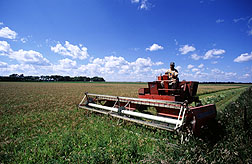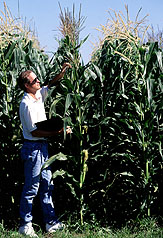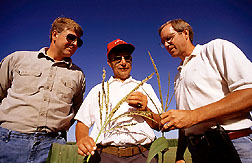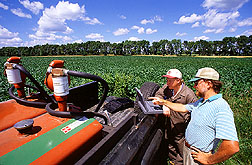Growers Support Research That Supports Farming
|
|
In the mid 1950s, in the small Minnesota town of Morris, a group of people pooled their resources and bought a place called Swan Lake Farm. In those days it was known for the birds that lived on the farm's lake.
But the collection of local conservation-minded business people and farm managers who purchased Swan Lake Farm—with its clay-loam soil developed under native prairie grasses—hoped that one day it would be known for something else: being a place where scientists could conduct field research to solve agricultural problems facing farmers. Even then, the farm's buyers knew the importance of research to farming.
"Research remains important because we still have to be able to increase yields," says Carl Anderson, president of the Barnes-Aastad Soil and Water Conservation Research Association. "Anything we can do to produce more while holding down costs will benefit farmers."
Anderson says the association bought Swan Lake Farm as a place where the Agricultural Research Service's North Central Soil Conservation Research Laboratory, also located in Morris, could conduct field experiments. Over the years, the partnership has remained strong.
The association hosts an annual business meeting that includes updates on lab activities and research, along with discussions about agricultural production problems. The meeting attracts about 100 participants including farmers, crop consultants, and representatives of agribusinesses and related government agencies.
Some of the research done to date includes studies on tillage and erosion, soil freezing, weed emergence in crops, and cross-pollinating of corn plants for better yields.
"Swan Lake plays an important role in the research conducted at the Morris lab because the soil conditions there are representative of those in the northwest Corn Belt, " says Ward B. Voorhees, a soil scientist who heads the Morris lab. "It's very productive and high in organic matter, but also subject to erosion because its land is gently rolling."
"We wanted to keep this regional and national research effort in our area so that we could have easy access to it," says Ron Barsness, a local farmer and member of the association who has cooperated with the Morris lab on various projects.
"Some of the scientists from ARS conducted weed emergence studies on my farm," he says. "The data they gathered gave me a way of predicting where and when the weeds would emerge, rather than just waiting for them to pop up.
"I have more control over my farming operation," adds Barsness. "I can fine-tune whatever type of methods I use in planting crops, instead of doing nothing until something happens that could potentially result in a loss."
One weed control innovation stemming from the lab's work at Swan Lake is called WeedCast. It's a computer program developed by agronomist Frank Forcella. WeedCast uses local weather data to predict emergence and growth of annual weeds in corn and soybeans. Local newspapers publish the predictions from WeedCast so farmers and crop consultants can better control weeds—thus saving money and causing fewer potential environmental concerns from herbicides.
The ARS researchers have been conducting studies on Barsness' land for 4 years. He says the research findings "will definitely be practical in the future."
The Conservation Reserve Program (CRP) established by the U.S. Congress about 10 years ago took erosion-prone farmland out of production and required that the land be seeded with grass. This helped reduce soil erosion and water pollution. But the program's cost has been high, because land owners have had to be compensated for lost crop production while the land was in permanent grass cover. Now that CRP contracts are expiring, much of the land is going back into crop production.
"We are conducting experiments on two farms in Minnesota and South Dakota to find ways to manage this land so that it doesn't revert to the erosive conditions that existed before it was put into the CRP," says Voorhees.
Research showed that soil quality has improved significantly on CRP land, mainly because the soil wasn't tilled each year—a process that destroys organic matter and increases soil erosion.
"Our research shows that just one tillage operation on CRP land can essentially erase the benefits gained from years of having the land out of production. We are concentrating on finding ways to bring this land back into production without subjecting it to annual tillage," says Voorhees.
But skipping tillage has its disadvantages. One is that weed control can be more challenging, requiring more herbicides. This may be offset, however, by the decreased erosion from no-till production.
USDA's Natural Resources Conservation Service uses ARS' research findings on CRP land in working with farm managers to develop best management practices to sustain agricultural production and protect the quality of soil and water resources.
Mixing Hybrids Maximizes Returns
Farmers could have a new way to get more return for their investment by simply mixing up their corn varieties. "Corn breeders have known for decades that certain hybrids—those not related genetically—yield more if pollinated by another hybrid, rather than being allowed to self-pollinate," says Mark E. Westgate, a plant physiologist studying cross-pollination of corn hybrids at the Morris lab.
Typically, a grower plants one or two corn hybrids in a field. During flowering, most plants self-pollinate or are pollinated by another plant of the same hybrid, which is called sib-pollination. "Self- and sib-pollination create a slight inbreeding problem, which can result in smaller corn kernels containing less oil and protein," says Westgate.
It's critical, he says, to choose the right hybrids to cross-pollinate. "Farmers here generally have about 120 days to get their seed planted and harvest their crops. The last day for frost in the spring is about May 15, and the first frost day in the fall is around September 15. I'm looking at hybrids that are designed to fit within this window. And the hybrids have to be as highly productive as possible, because there's no time to waste in our short growing season."
Pollen is airborne, and corn silks are not very selective about where the pollen comes from. So all that may be required to take advantage of cross-pollination is planting the right hybrids next to each other. Cross-pollination doesn't cost the farmer money or time. It's just a matter of changing how seeds are planted in the field. According to John Dosdall, a farmer and member of the Barnes-Aastad Association, "All you have to do is place different matched varieties in every other box on the planter."
Recent studies at South Dakota State University (SDSU) showed up to 7 percent greater yields from hybrid pairs whose pollen was allowed to mingle in the field. Westgate says the yield advantages from cross-pollination could be seen in bigger kernels on the ears.
In 7 years of tests with six hybrids, cross-pollination consistently increased kernel weight and protein. The increased protein allows growers who feed their corn to their hogs to decrease the protein supplement in the feed.
Results from small-scale field trials at SDSU show the greatest kernel size increases resulted from cross-pollination between hybrids that had no common parents. In crosses between hybrids with one common parent, there was only a slight advantage—about 2 percent. Maximum cross-pollination occurs when both hybrids have silks emerged and are shedding pollen at the same time.
"SDSU's work laid the foundation for our research," says Westgate. "But the potential benefits from cross-pollinating corn hybrids needed to be tested in a large-scale field study under typical production conditions."
So researchers at the Morris lab are conducting cross-pollination trials in cooperation with several seed companies and with CENTROL Crop Consulting of Morris, a company hired by growers to give them farming and business advice. Westgate is working with 40 different farms in the Morris area on mixing corn hybrids at planting.
"Our goals are to identify favorable hybrid combinations for yield and protein content and to spot potential management problems associated with planting mixed hybrids," Westgate says. "We held meetings and asked if anyone was interested in testing how cross-pollination might affect the performance of their favorite corn hybrids. We got a good response from CENTROL's clients.
"It was a great opportunity for cooperation," says Westgate, "because CENTROL has a direct connection with hundreds of growers. "It also helps ARS, because the growers themselves are assessing the value of our research and passing it on to other growers. It's an immediate transfer of basic research to end users—that's the value of this approach."
The research has several implications for corn producers. It could be a simple means of getting a few more bushels of grain or pounds of protein out of those increasingly expensive hybrids—without additional input.
|
|
It also raises the possibility that an individual hybrid's performance in a uniform-strip trial might be affected by its nearest neighbors. Planting the hybrids in a different pattern might be enough to change the ranking.
Finally, it might alter the way producers select new hybrids in the future. How any pair responds to cross-pollination could be an important consideration for top performance.
"This ongoing research is going to make us better producers," says Dosdall. "The researchers can help us with our farming practices, and we can help them by offering our land for testing. It's a two-way street."
Water Movement in Frozen Soil
It was previously assumed that once a soil was frozen, all activity in the soil ceased.
"Our research, however, has shown that as the soil freezes, water in the soil below the frozen layer migrates up to the frozen layer," says Voorhees. "So even though there may not be any change in the total water content in the soil, the distribution of the soil water may be different."
For example, Voorhees says that 12 inches below the surface the soil may be saturated in the spring when the soil thaws out, even though there was no precipitation going into the soil during the winter.
When water moves upward in the soil toward the frozen layer, it also carries things like nitrates and herbicides. This can be important because if the soil is very wet during spring thaw, some of the spring rain will cause runoff and carry nitrates and other chemicals with it.
On the other hand, Voorhees adds, if water and chemicals in the soil move upward toward the frozen layer, that may prevent the chemicals from leaching downward and getting into the groundwater supply.
"Another aspect of soil freezing is that some herbicides are applied in the fall before soil freezing occurs. This saves time in the spring, when farm work is busiest," says Voorhees. "We have a grant to determine how much, if any, of a certain herbicide leaves the soil during the winter months. This study is still in progress, so we have no practical information ready for farmers yet."
But Voorhees says the lab has informed farmers how they can control the depth that soil freezes. "This is most easily done by leaving plant material on the soil surface after harvest to catch drifting snow. A deep layer of snow is very good insulation and keeps the soil from freezing too deep," he says.
"The problem is, we don't yet have sufficient information to develop guidelines to help the farmer know if deep freezing is desirable," adds Voorhees. "It depends on other potential problems, such as soil compaction."
"The farms of yesteryear are changing so fast, it's hard to keep up without research," says Dosdall. "The scientists at the North Central Soil Conservation Laboratory continue to play an important part in helping farmers keep pace with change." — By Tara Weaver
Ward B. Voorhees, and Frank Forcella are at the USDA-ARS North Central Soil Conservation Research Lab., 803 Iowa Ave., Morris, MN 56267; phone (320) 589-3411 ext. 182










